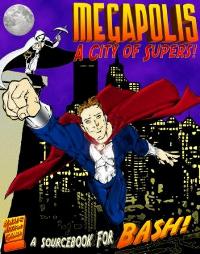Megapolis

Megapolis is a fictional major US city located somewhere on the Eastern Seaboard. Its location is intentionally left vague in order to allow the Narrator to place the city where they choose. It is the official campaign setting of BASH! Basic Action Super Heroes.
History[edit]
[Excerpts used by permission] Early History
Megapolis began as the township of Meganville, and was founded in the late 17th century. The town was named for Megan’s Bay, which was in turn named after the wife of the captain who discovered the bay. Meganville grew into a prosperous shipping hub by the mid 1700s. Its river access and protected harbor made it an ideal place for merchants to stop and drop their wares, where river barges would move grain from the country and goods from the city back and forth. The forest to the west also helped make shipbuilding a major part of Meganville’s economy. During the American Revolution, Meganville had little part to play as it was occupied for nearly the duration of the war by the British army. Most of the residents at the time were Tories, in any case, as their livelihoods depended so heavily on trade with Britain. By the war of 1812, however, the residents of Meganville had become staunchly patriotic, as the British impressment of American sailors, and the blockade of European ports shut down the city’s source of income! The British were unable to take the city because of the incredibly well defended island fortress at Bradbury Heights, whose cannons were able to bombard everywhere within the bay. In the 1850s, Meganville was the hometown of a very outspoken abolitionist senator, Charles Blake. He created so many enemies amongst the slaveholders that there were no less than four attempts on his life before the outbreak of the Civil War. With the coming of the war, Blake traded his senate seat for a General’s star and served in the Union Army gallantly until 1865, when he was killed by a stray bullet. Blake Square in East View is still there today, honoring the man with a bronze statue, and his famous words, “He who gives his life for Liberty can never truly die.”
Rise of Titan Steel
In the 19th century, the Township of Meganville grew exponentially, and by 1890, its name was changed to Megapolis. At this time, the city was the headquarters of the steel baron Allen McKlintock. McKlintock's company, Titan Steel, virtually owned the city, and controlled the press and the political machine. The Depression lowered wages, but Titan Steel did not collapse. During World War II, the demand for steel skyrocketed, furthering profits. 1944, Allen McKlintock died, leaving most of his money to various relatives, and an ample percentage of it for the construction of various public works, each bearing his name, so that the history books might style him some sort of philanthropist. To this day, there is a McKlintock Museum, Library, Orphanage, and Hospital in Megapolis as a result of his last ego trip.
Golden Age
During World War II, Megapolis was one among several US cities that spawned superheroes. Megapolis natives Kid Dynamo, American Wonder, Major Tank (a former villain who chose service instead of jail time), and a mysterious ghost of the revolution called The Unknown Soldier formed a group called “The Four Freedoms”. Throughout the war, they destroyed enemy ships, factories, and tank columns, lending a helping hand to the Allied forces. Unfortunately, the Axis had “heroes” of its own, and none more dangerous than Uberman: The Man of Iron. In order for the invasion of Normandy to succeed, the US Army needed Uberman “distracted”. The Four Freedoms knew that all of the other heroes who’d distracted Uberman received medals—posthumously. They volunteered nonetheless, and set out to strike at a Nazi-controlled heavy water plant in Norway, where Nazi scientists were perfecting a “super bomb” (a nuclear device). Uberman arrived (as they planned) to defend the plant. A melee ensued, and a nuclear flash was seen over the horizon. All the Four Freedoms were presumed dead, but it was also the last anyone saw of Uberman! A statue was placed in Titan Park commemorating American Wonder, Kid Dynamo, and Major Tank, Megapolis’ native sons, and the sacrifice they made for their country.
Silver Age
The number of superheroes and villains began increasing exponentially by this time. This was creating problems for law enforcement and the legal system, as numerous super-villains were having their convictions overturned when superheroes did not read them their rights, acquire warrants, or testify against them in court. For this reason, Congress passed the Superhero Registry Act, which called for all supers who wished to use their powers for law enforcement to register with the government. The registry ensures that the individuals are responsible for excess property damage, testifying in court, etc. Essentially, it is a “hero license” and to practice superheroics without one is a crime! The hero license allows a hero to use their super identification as ordinary identification without compromising their secret identities. The government also created an organization known as URGENT to monitor the actions of superheroes, and ensure they were doing their jobs responsibly.
During this time, Megapolis' most famous superhero was Titan, an incredibly strong hero, who was nearly indestructible. Because of the threat of the Cold War, and other outside menaces, Titan left Megapolis to form a national superhero team called the Legion of Liberty, which was based in Washington DC.
Bronze Age
Modern Era